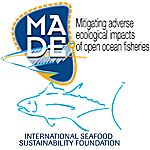Natural floating objects such as logs or branches have always been a component of the habitat of tropical tunas. However, the introduction of artificial floating objects (fish aggregating devices - FADs) modifies this habitat. In order to quantitatively and qualitatively assess how much those FADs modify the offshore pelagic habitat, we compared the spatial distribution of natural and artificial floating objects. We used data from Spanish and French observers onboard tuna purse seiners in the Western Indian Ocean from December 2006 to December 2008. We divided the Indian Ocean into cells using grids of 1°, 5° and 10° and calculated the percentage of FADs being in cells without logs. FADs and logs appear to have different spatial distributions at the scale of 1°, but similar ones from the scale of 5°. The major change due to the introduction of FADs concerns the number of floating objects. Except in the Mozambique Channel and Chagos, the number of FADs is multiplied by 2 at least everywhere, and can reach up to 20 and 40 (Somalia area). These results are discussed in relation to the Ecological Trap hypothesis.
- Presentation

 PDF version
PDF version
